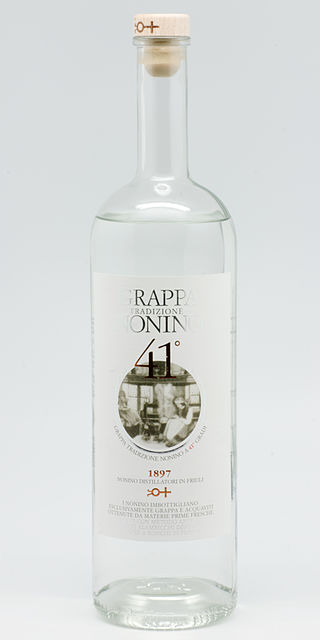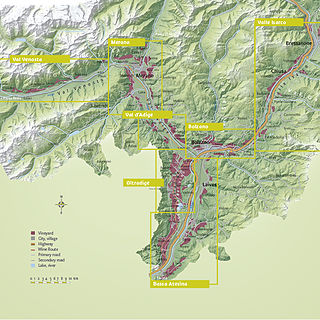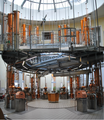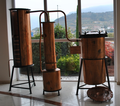
Brandy is a liquor produced by distilling wine. Brandy generally contains 35–60% alcohol by volume and is typically consumed as an after-dinner digestif. Some brandies are aged in wooden casks. Others are coloured with caramel colouring to imitate the effect of aging, and some are produced using a combination of aging and colouring. Varieties of wine brandy can be found across the winemaking world. Among the most renowned are Cognac and Armagnac from south-western France.

Tsipouro is an un-aged brandy from Greece and in particular Thessaly, Epirus, Macedonia. Tsipouro is a strong distilled spirit containing 40–45% alcohol by volume and is produced from either the pomace or from the wine after the grapes and juice have been separated. Tsipouro is typically produced in two varieties: anise-flavored, which is the default, and pure, which contains no anise and is specifically labeled as 'without anise.' While tsipouro is usually not aged in barrels, barrel-aged versions are also available. It is similar to tsikoudia produced on the island of Crete, but unlike tsikoudia, which is single-distilled and contains no additional flavorings, tsipouro is typically double-distilled and frequently includes spices, primarily anise.

Maraschino is a liqueur obtained from the distillation of Marasca cherries. The small, slightly sour fruit of the Marasca cherry tree, which grows wild along parts of the Dalmatian coast in Croatia, lends the liqueur its unique aroma.

Grappa is an alcoholic beverage: a fragrant, grape-based pomace brandy of Italian origin that contains 35 to 60 percent alcohol by volume. Grappa is a protected name in the European Union.

Zivania or zivana is a Cypriot pomace brandy produced from the distillation of a mixture of grape pomace and local dry wines made from Xynisteri and Mavro grapes. The name of zivania is derived from zivana which means pomace in the Greek dialect of Cyprus. Zivania is colourless and alcoholic with a light aroma of raisins. Its alcohol content varies, with 45% by volume being the typical value. As defined by law, zivania cannot have more than 60% alcohol content. Zivania contains no sugar and has no acidity.

Orujo is a pomace brandy from northern Spain. It is a transparent spirit with an alcohol content over 50%. Its name comes from the expression "aguardiente de orujo".

A microdistillery is a small, often boutique-style distillery established to produce beverage grade spirit alcohol in relatively small quantities, usually done in single batches. While the term is most commonly used in the United States, micro-distilleries have been established in Europe for many years, either as small cognac distilleries supplying the larger cognac houses, or as distilleries of single malt whisky originally produced for the blended Scotch whisky market, but whose products are now sold as niche single malt brands. The more recent development of micro-distilleries can now also be seen in locations as diverse as London, Switzerland, and South Africa.
TGR is the brand for Italian state-owned public broadcasting company Rai's regional news programmes. They are broadcast domestically on Rai Tre and Rai Radio 1. It was launched in 1979 as TG3 Regione, and was known as Rai Regione from 1987-1992 before adopting the current TGR name from 1992-1999 and again from 2002 onwards. Today with about 800 journalists is Europe's largest broadcast news organisation..
Poli Distillerie is an artisan Grappa distillery solely owned by the Poli family, founded in 1898 in Schiavon, near Bassano del Grappa, in the heart of Veneto, Italy. The distillery is currently run by Jacopo Poli together with his siblings Giampaolo, Barbara and Andrea.

Nonino is a small Italian company that is a producer of grappa. Nonino is also the name of the family that owns and runs the brand Nonino Grappa. The first Nonino distillery was founded by Orazio Nonino in Ronchi di Percoto, Pavia di Udine, in the Friuli region in northeastern Italy, in 1897.

Applejack is a strong alcoholic drink produced from apples. Popular in the American colonial era, the drink's prevalence declined in the 19th and 20th centuries amid competition from other spirits.
Vancimuglio is a frazione of the comune of Grumolo delle Abbadesse, in the province of Vicenza, Veneto, northern Italy.

The South Tyrolian People's Bank is an Italian bank headquartered in Bolzano. The bank originated as a cooperative bank, but demututalized in 2016.

South Tyrol is an autonomous province located in northeast Italy producing wine. This Austro-Italian wine region is noted for the distinct Austrian influences on the wine industry, due to the region's long history under the rule of Austria-Hungary and Holy Roman Empires.

The Venetian Prealps are a mountain range in the south-eastern part of the Alps. They are located in Triveneto, in the north-eastern part of Italy.

The Trento–Venice railway is an Italian state-owned railway line connecting Trento, in Trentino-Alto Adige, to Mestre, a suburb of Venice, in the Veneto region. At Mestre, it connects to the main line from Verona.
Libero Cecchini was an Italian architect. He specialized in restoration of monuments and the design of residential complexes.

The 42nd Signal Battalion "Pordoi" is an inactive signals battalion of the Italian Army. The unit was formed in 1953 as a battalion, which operated and maintained the army's telecommunication network in the Friuli-Venezia Giulia, Trentino-Südtirol, and Veneto regions. In 1975 the battalion was named for the Pordoi Pass and received its own flag. In 1993 the battalion was disbanded and its personnel and tasks transferred to the 32nd Signal Regiment. In 2001 the battalion was reformed as the second signal battalion of the deployable 2nd Alpine Signal Regiment. The regimental anniversary falls, as for all signal units, on June 20, the height of the Second Battle of the Piave River in 1918.


















